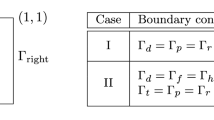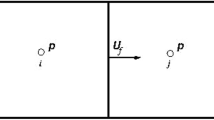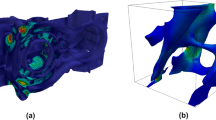Abstract
The numerical stability of implicit (semi-implicit) predictor/corrector co-simulation methods, where the subsystem solvers are coupled by applied forces/torques (i.e., by constitutive equations), has recently been examined by Schweizer and Lu (Arch Appl Mech, 2014. doi:10.1007/s00419-014-0883-5) and Schweizer et al. (J Comput Nonlinear Dyn, 2014. doi:10.1115/1.4028503). Here, we present implicit (semi-implicit) co-simulation methods with improved stability properties. Enhanced stability behavior can be achieved by extending the coupling conditions, i.e., by taking into account derivatives and integrals of the constitutive equations. The stability of the presented co-simulation methods is analyzed by means of a co-simulation test model, which represents two coupled Dahlquist equations. By discretizing the test model with a co-simulation approach, a linear recurrence equation system is obtained, the stability of which defines the numerical stability of the underlying co-simulation method. Results are presented for the three possible decomposition approaches, namely for force/force, force/displacement and displacement/displacement decomposition. Here, co-simulation methods are derived for coupling two mechanical systems. The presented methods may, however, also be applied to couple arbitrary non-mechanical systems.


















Similar content being viewed by others
References
Alioli, M., Morandini, M., Masarati, P.: Coupled multibody-fluid dynamics simulation of flapping wings. In: Proceedings of the ASME IDETC/CIE 2013, Portland, Oregon, USA, DETC2013-12198, 4–7 August 2013
Ambrosio, J., Pombo, J., Rauter, F., Pereira, M.: A memory based communication in the co-simulation of multibody and finite element codes for pantograph–catenary interaction simulation. In: Bottasso, C.L. (ed.) Multibody Dynamics: Computational Methods and Applications, pp. 231–252. Springer, Berlin (2009)
Ambrosio, J., Pombo, J., Pereira, M., Antunes, P., Mosca, A.: A computational procedure for the dynamic analysis of the catenary–pantograph interaction in high-speed trains. J. Theor. Appl. Mech. 50(3), 681–699 (2012)
Anderson, K.S.: An order-n formulation for the motion simulation of general multi-rigid-body tree systems. Comput. Struct. 46(3), 547–559 (1993)
Anderson, K., Duan, S.: A hybrid parallelizable low-order algorithm for dynamics of multi-rigid-body systems: part I, chain systems. Math. Comput. Model. 30(9–10), 193–215 (1999)
Arnold, M.: Stability of sequential modular time integration methods for coupled multibody system models. J. Comput. Nonlinear Dyn. 5, 1–9 (2010)
Busch, M., Schweizer, B.: Numerical stability and accuracy of different co-simulation techniques: analytical investigations based on a 2-DOF test model. In: Proceedings of the 1st Joint International Conference on Multibody System Dynamics, IMSD 2010, Lappeenranta, Finland, 25–27 May 2010
Busch, M., Schweizer, B.: Coupled simulation of multibody and finite element systems: an efficient and robust semi-implicit coupling approach. Arch. Appl. Mech. 82(6), 723–741 (2012)
Busch, M., Schweizer, B.: An explicit approach for controlling the macro-step size of co-simulation methods. In: Proceedings of the 7th European Nonlinear Dynamics, ENOC 2011, Rome, Italy, 24–29 July 2011
Carstens, V., Kemme, R., Schmitt, S.: Coupled simulation of flow–structure interaction in turbomachinery. Aerosp. Sci. Technol. 7, 298–306 (2003)
Cuadrado, J., Cardenal, J., Morer, P., Bayo, E.: Intelligent simulation of multibody dynamics: space-state and descriptor methods in sequential and parallel computing environments. Multibody Syst. Dyn. 4, 55–73 (2000)
Datar, M., Stanciulescu, I., Negrut, D.: A co-simulation framework for full vehicle analysis. In: Proceedings of the SAE 2011 World Congress, SAE Technical Paper 2011–01-0516, 12–14 April, Detroit, Michigan, USA (2011)
Datar, M., Stanciulescu, I., Negrut, D.: A co-simulation environment for high-fidelity virtual prototyping of vehicle systems. Int. J. Veh. Syst. Model. Test. 7, 54–72 (2012)
Dörfel, M.R., Simeon, B.: Analysis and acceleration of a fluid–structure interaction coupling scheme. In: Numerical Mathematics and Advanced Applications, pp. 307–315 (2010)
Eberhard, P., Gaugele, T., Heisel, U., Storchak, M.: A discrete element material model used in a co-simulated charpy impact test and for heat transfer. In: Proceedings 1st International Conference on Process Machine Interactions, Hannover, Germany, 3–4 September 2008
Friedrich M., Ulbrich, H.: A parallel co-simulation for mechatronic systems. In: Proceedings of The 1st Joint International Conference on Multibody System Dynamics, IMSD 2010, Lappeenranta, Finland, 25–27 May 2010
Gear, C.W., Wells, D.R.: Multirate linear multistep methods. BIT 24, 484–502 (1984)
Gonzalez, F., Gonzalez, M., Cuadrado, J.: Weak coupling of multibody dynamics and block diagram simulation tools. In: Proceedings of the ASME 2009 International Design Engineering Technical Conferences & Computers and Information in Engineering Conference, IDETC/CIE 2009, San Diego, California, USA, August 30–September 2, 2009
Gu, B., Asada, H.H.: Co-simulation of algebraically coupled dynamic subsystems without disclosure of proprietary subsystem models. J. Dyn. Syst. Meas. Control 126, 1–13 (2004). doi:10.1115/1.1648307
Hairer, E., Norsett, S.P., Wanner, G.: Solving Ordinary Differential Equations I: Nonstiff Problems, 3rd edn. Springer, Berlin (2009)
Hairer, E., Wanner, G.: Solving Ordinary Differential Equations II: Stiff and Differential-Algebraic Problems, 2nd edn. Springer, Berlin (2010)
Hippmann, G., Arnold, M., Schittenhelm, M.: Efficient simulation of bush and roller chain drives. In: Goicolea, J., Cuadrado, J., Orden, J.G. (eds.) Proceedings of ECCOMAS Thematic Conference on Advances in Computational Multibody Dynamics, Madrid, pp. 1–18 (2005)
Kübler, R., Schiehlen, W.: Two methods of simulator coupling. Math. Comput. Model. Dyn. Syst. 6, 93–113 (2000)
Lacoursiere, C., Nordfeldth, F., Linde, M.: A partitioning method for parallelization of large systems in realtime. In: Proceedings of the 3rd Joint International Conference on Multibody System Dynamics and the 7th Asian Conference on Multibody Dynamics, IMSD 2014, ACMD 2014, Bexco, Busan, Korea, June 30–July 3, 2014
Laflin, J.J., Anderson, K.S., Khan, I.M., Poursina, M.: Advances in the application of the divide-and-conquer algorithm to multibody system dynamics. J. Comput. Nonlinear Dyn. (2014). doi:10.1115/1.4026072
Lehnart, A., Fleissner, F., Eberhard, P.: Using SPH in a co-simulation approach to simulate sloshing in tank vehicles. In: Proceedings SPHERIC4, Nantes, France, 27–29 May 2009
Liao, Y.G., Du, H.I.: Co-simulation of multi-body-based vehicle dynamics and an electric power steering control system. Proc. Inst. Mech. Eng. K J. Multibody Dyn. 215, 141–151 (2001)
Malczyk, P., Fraczek, J.: Evaluation of parallel efficiency in modeling of mechanisms using commercial multibody solvers. Arch. Mech. Eng. LVI(3), 237–249 (2009)
Meynen, S., Mayer, J., Schäfer, M.: Coupling algorithms for the numerical simulation of fluid–structure-interaction problems. In: ECCOMAS 2000: European Congress on Computational Methods in Applied Sciences and Engineering, Barcelona (2000)
Naya, M., Cuadrado, J., Dopico, D., Lugris, U.: An efficient unified method for the combined simulation of multibody and hydraulic dynamics: comparison with simplified and co-integration approaches. Arch. Mech. Eng. LVIII, 223–243 (2011)
Negrut, N., Melanz, D., Mazhar, H., Lamb, D., Jayakumar, P.: Investigating through simulation the mobility of light tracked vehicles operating on discrete granular terrain. SAE Int. J. Passeng. Cars Mech. Syst. 6, 369–381 (2013). doi:10.4271/2013-01-1191
Schäfer, M., Yigit, S., Heck, M.: Implicit partitioned fluid–structure interaction coupling. In: ASME, PVP2006-ICPVT11-93184, Vancouver, Canada (2006)
Schmoll, R., Schweizer, B.: Co-simulation of multibody and hydraulic systems: comparison of different coupling approaches. In: Samin, J.C., Fisette, P. (eds.) Multibody Dynamics 2011, ECCOMAS Thematic Conference, Brussels, Belgium, 4–7 July 2011, pp. 1–13
Schweizer, B., Lu, D.: Predictor/corrector co-simulation approaches for solver coupling with algebraic constraints. ZAMM J. Appl. Math. Mech. (2014). doi:10.1002/zamm.201300191
Schweizer, B., Lu, D.: Semi-implicit co-simulation approach for solver coupling. Arch. Appl. Mech. (2014). doi:10.1007/s00419-014-0883-5
Schweizer, B., Lu, D.: Co-simulation methods for solver coupling with algebraic constraints: semi-implicit coupling techniques. In: Proceedings of the 3rd Joint International Conference on Multibody System Dynamics and the 7th Asian Conference on Multibody Dynamics, IMSD 2014, ACMD 2014, Bexco, Busan, Korea, June 30–July 3, 2014
Schweizer, B., Lu, D.: Stabilized index-2 co-simulation approach for solver coupling with algebraic constraints. Multibody Syst. Dyn. (2014). doi:10.1007/s11044-014-9422-y
Schweizer, B., Li, P., Lu, D.: Explicit and implicit co-simulation methods: stability and convergence analysis for different solver coupling approaches. J. Comput. Nonlinear Dyn. (2014). doi:10.1115/1.4028503
Schweizer, B., Li, P., Lu, D., Meyer, T.: Stabilized implicit co-simulation method: solver coupling with algebraic constraints for multibody systems. J. Comput. Nonlinear Dyn. (2015). doi:10.1115/1.4030508
Solcia, T., Masarati, P.: Efficient multirate simulation of complex multibody systems based on free software. In: Proceedings of the ASME IDETC/CIE 2011, Washington, DC, USA, DETC2011-47306, 28–31 August 2011
Spreng, F., Eberhard, P., Fleissner, F.: An approach for the coupled simulation of machining processes using multibody system and smoothed particle hydrodynamics algorithms. Theor. Appl. Mech. Lett. 3(1), 8–013005 (2013)
Verhoeven, A., Tasic, B., Beelen, T.G.J., ter Maten, E.J.W., Mattheij, R.M.M.: BDF compound-fast multirate transient analysis with adaptive stepsize control. J. Numer. Anal. Ind. Appl. Math. 3(3–4), 275–297 (2008)
Zierath, J., Woernle, C.: Development of a Dirichlet-to-Neumann Algorithm for contact analysis in boundary element systems and its application to MBS-BEM co-simulation. In: Samin, J.C., Fisette, P. (eds.) Multibody Dynamics 2011, ECCOMAS Thematic Conference, Brussels, Belgium, 4–7 July 2011
Zierath, J., Woernle, C.: Contact modelling in multibody systems by means of a boundary element co-simulation and a Dirichlet-to-Neumann Algorithm. In: Oñate, E. (Series ed.) Computational Methods in Applied Sciences. Springer, Berlin (2012)
Author information
Authors and Affiliations
Corresponding author
Rights and permissions
About this article
Cite this article
Schweizer, B., Li, P., Lu, D. et al. Stabilized implicit co-simulation methods: solver coupling based on constitutive laws. Arch Appl Mech 85, 1559–1594 (2015). https://doi.org/10.1007/s00419-015-0999-2
Received:
Accepted:
Published:
Issue Date:
DOI: https://doi.org/10.1007/s00419-015-0999-2




